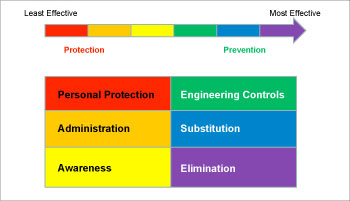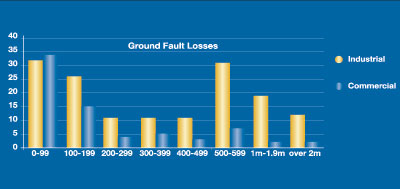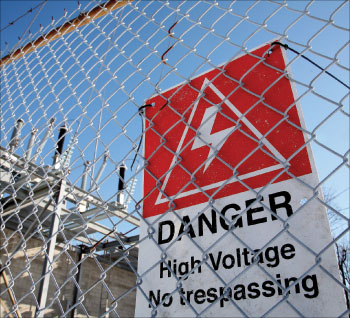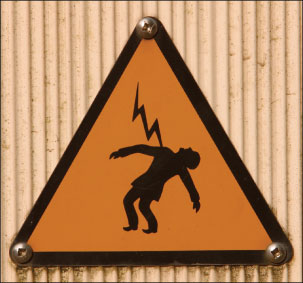Despite awareness campaigns, industry statistics and loss summaries, annual safety conferences and numerous industry associations driving the safety message, we still more often than not take a reactive rather than proactive approach to electrical safety.
I am not pointing fingers or sermonizing because I was reactive, and I did not take electrical safety as seriously as I should have until we had an electrical fire. Around three o’clock one morning my son came into our bedroom and shouted that his bedroom was on fire. We rushed out of bed, saw the flames for ourselves (by which time the solitary smoke alarm on the upper level decided to sound), woke the other two younger children, made our way downstairs and I called 911 while my wife put the kids in the car. A few moments later we were all safe, watching our house burn and the firefighters doing their job admirably.
Thankfully, no one was injured. The two older children had received some fire safety education at school and so we had a defined escape route but beyond this we were not adequately prepared for such an event. Sure, we had smoke alarms on each level of the home and one fire extinguisher, but this was sorely inadequate. The investigation showed there to be a wiring issue that led to overheating of a lamp resulting in ignition of insulation material, and we discussed with the fire department corrective action that we could easily undertake.

Figure 1. Risk Control Hierarchy
Damage was minimal at $24,000 but by far the bigger impact was the inconvenience of spending twelve weeks living in a hotel, filling out insurance form after insurance form, hunting for receipts to validate date of purchase and amount so that claims could be processed, buying new clothes and trying to replace personal items.
Once we returned to the repaired home, we installed smoke alarms in every bedroom; we installed carbon monoxide detectors on every level; we strategically placed fire extinguishers on every level and we once again reviewed our fire escape plan. It was then that I came across an article on Risk Control Hierarchy and realized that while the steps we had taken were all valid, they were aimed at protection not prevention; they were aimed at reacting quicker and more effectively to the next incident

Figure 2. Ground fault losses
The smoke alarms in every room provided personal protection, as did the fire extinguishers; the practice of no extension cords or extension plugs as a safe practice provided an administrative response of being safer and avoiding overheating; the continued practicing and establishment of escape routes provided an awareness of how to react, but none of these actually prevented another event from occurring. I had spent $100 on additional alarms, etc., to react quicker and more effectively but had not implemented one real change that would avoid the next electrical fire. We then started to look closer at the idea of more effective electrical panels and outlets, lowering or substituting our risk and, of course, options for eliminating the risk. We had a new electrical panel installed with AFCI (arc-fault circuit interrupters) for all bedroom circuits; we had all of our electrical outlets replaced and our aluminum wiring updated with copper tails; and, finally, we implemented the simple but effective step of unplugging anything in the bedrooms at the end of each night. This investment in prevention cost $2,800 and allowed us to avoid any further incident. With a little foresight and being proactive instead of reactive, this investment of $2,800 would likely have avoided the fire, the inconvenience, the replacement and rebuild cost of $24,000. If only I had viewed the $2,800 not as an expense but as an investment in avoiding a greater issue.
Unfortunately, we remain reactive in industry where the losses are even more significant and the frequency of electrical fires higher, and whether we are the safety officer, the operations manager, the facilities engineer, the CEO or an insurance associate, we can and must change our approach.
Impact of both direct and indirect costs
One leading U. S. based insurance company notes that over a 7-year period their clients reported 228 losses that were attributed to ground faults, resulting in payments of $180 million. There were 72 occurrences in the commercial sector, hotels, universities, hospitals and shopping malls at an average cost of $830,000 and 156 occurrences in manufacturing locations with an average cost of $769,000.
At the same time, we have statistics that suggest that in North America there are 5–7 arc flash incidents per day that require hospitalization.
A review of the costs shows the impact of both direct and indirect costs. On the direct side are the costs associated with equipment repair and replacement as well as the direct medical costs associated with injuries. On the indirect side, we see the cost of business interruption in terms of unscheduled delays, employee training and redeployment, accident investigation, legal costs and possible fines, etc.
Quite often the impact on business interruptions and the indirect costs significantly outweigh the direct costs. The U. S. National Fire Protection Association notes, “During the five-year period of 1994 through 1998, an estimated average of 16,900 reported industrial and manufacturing structure fires caused 18 civilian deaths, 556 civilian injuries, and $789.6 million in direct property damage per year.” From this we can estimate that the average equipment and property damage from an electrical fire is $ 46,700.
There is a significant human cost to electrical accidents, and arc-flash victims may suffer from chronic pain and scarring. Workers may also have difficulty re-integrating into the community and may experience anxiety, depression, or other psychological symptoms. The social and economic costs may also be high. Workers’ compensation pays only a portion of lost wages. Some workers may not be able to return to their pre-injury job. Employers bear the costs associated with lost productivity, reduced competitiveness, and employee rehiring and retraining, as well as being subject to increases in workers’ compensation premiums.
Published data from Washington State Department of Labor and Industries notes that from September 2000 through December 2005, 350 Washington workers were hospitalized for serious burn injuries occurring at work. Of these, 30 (9%) were due to arc-flash/blast explosions. Total Workers’ Compensation costs associated with these 30 claims exceeded $1.3 million, including reimbursement for almost 1,800 days of lost work time. From this we can estimate that the indirect impact in terms of personnel costs for an electrical incident average $43,000.
Business interruptions due to unscheduled downtime, repair, spoilage, etc., varies by industry with per hour costs ranging from $15,000 per hour for automotive companies to $24,000 per hour for mining and metal companies to $90,000 per hour for airline reservation companies.
When we add the equipment and property damage estimates to the personnel costs to the business interruption costs and then add possible OSHA fines and other indirect costs, it is quite easy to total in excess of $500,000 per incident, in line with the experience of the major insurance company detailed above.
Protection versus prevention

The most common grounding method in use in North America for both commercial and industrial facilities is called solidly grounding; in this method, the neutral points have been intentionally connected to earth ground with a conductor having no intentional impedance. This partially reduces the problem of transient overvoltages associated with ungrounded systems as was the primary reason for the growth of this option from the 1970s onwards. However, this grounding method has the highest incident level of arc-flash events and electrical fires. There are estimated to be around 60,000 industrial facilities in North America that operate ungrounded and 210,000 industrial facilities that operate solidly grounded despite the higher level of risk.
The least common, but safest, grounding method in use today in North America is resistance grounding where a resistor is connected between the neutral of the transformer secondary and the earth ground. The reasons supporting this option for electrical grounding can be found in several IEEE (Institute

Figure 4. Lightning sign
of Electrical and Electronic Engineers) reference guides.
IEEE Standard 142-1991 Recommended Practice for Grounding of Industrial and Commercial Power Systems
1.4.3 The reasons for limiting the current by resistance grounding may be one or more of the following.
To reduce the arc blast or flash hazard to personnel who may have accidentally caused or who happen to be in close proximity to the ground fault.
IEEE Standard 141-1993 Recommended Practice for Electric Power Distribution for Industrial Plants
7.2.2 There is no arc flash hazard, as there is with solidly grounded systems, since the fault current is limited to approximately 5 amperes. Another benefit of high-resistance grounded systems is the limitation of ground fault current to prevent damage to equipment.
There have been technical advances in the detection and mitigation of arc blasts in terms of current-limiting fuses, thermal ionization detectors, optical arc detection relays; and these, in addition to resistance grounding, offer an engineering approach to reducing the risk and substituting the risk with a lower level of risk, and yet they are little used either by the consulting or engineering community; nor are they requested by safety officers or facility managers; nor are they promoted by the insurance industry.
The cost of investing in prevention technology ranges depending on the size and complexity of the operation being protected and is likely from $15,000 to $100,000 but in all instances far below the $700,000 cost impact of ground-fault losses experienced by one leading insurance company. The likely payback in investing in prevention technology is for sure less than 1 year and more likely 1–6 months.
There was a recent electrical fire at a recreational facility that resulted in consequential damages of $1 million, mostly in business interruption costs; and as the forensic engineers and insurance investigators conducted their review, the focus was on product failure and who was to blame. They reviewed all aspects of the electrical equipment that was specified and installed, including settings and commissioning reports, but not once did they stop to ask themselves if the decision by the consulting engineer to specify a solidly grounded system was a contributing factor. Industry data advises us that this is the grounding method with the highest likelihood of arc-flash hazard; why then, when it occurs, do we question everything but the chosen method? There are practical reasons for specifying a solidly grounded system, especially if there is an abundance of neutral loads to be served; but in this scenario, surely there is a responsibility on the specifying engineer and the operating owner to ensure that mitigation technologies such as ZSIP or optical arc detection are installed so that when an arc occurs — and at some point in the life of the equipment it is probable — then the impact is limited and safety assured.
There is a place in industrial and commercial facilities, as there is in our own homes, for protection options; we should be made aware and understand the risks involved with electricity, we should have the necessary protection clothing and equipment, we should complete electrical safety awareness training, but we must also start to take a more proactive stance and start to invest in prevention technology.
I contacted my insurance broker after the house fire and advised that I was installing new smoke alarms, etc., and was advised that if they were wired into the telephone system so that 911 was automatically called in the event an alarm was triggered I could save 10% on my monthly insurance costs and this more than covered the cost. I called again to advise that I was updating the wiring, installing a new electrical panel with AFCI breakers, etc., to reduce if not eliminate the root causes and was told no reduction premium was available. If I take protection measures to react quicker, I receive a benefit and incentive from the insurance industry; but if I make a more significant investment in prevention measures, then the insurance industry is sitting on the sidelines.
Prevention technology is available, it should be our first choice not our last choice. As industry leaders we must view it as an investment not as a cost; as safety professionals or facilities managers we must change our approach from protection to prevention; the payback is definable and real and it sure would help if the insurance companies provided some support.
It is time to get serious about electrical safety.










Find Us on Socials